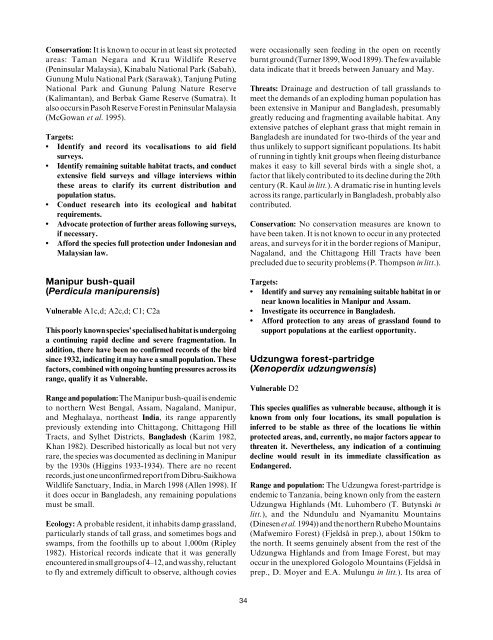Partridges, Quails, Francolins, Snowcocks, Guineafowl, and Turkeys
Partridges, Quails, Francolins, Snowcocks, Guineafowl, and Turkeys
Partridges, Quails, Francolins, Snowcocks, Guineafowl, and Turkeys
You also want an ePaper? Increase the reach of your titles
YUMPU automatically turns print PDFs into web optimized ePapers that Google loves.
Conservation: It is known to occur in at least six protected<br />
areas: Taman Negara <strong>and</strong> Krau Wildlife Reserve<br />
(Peninsular Malaysia), Kinabalu National Park (Sabah),<br />
Gunung Mulu National Park (Sarawak), Tanjung Puting<br />
National Park <strong>and</strong> Gunung Palung Nature Reserve<br />
(Kalimantan), <strong>and</strong> Berbak Game Reserve (Sumatra). It<br />
also occurs in Pasoh Reserve Forest in Peninsular Malaysia<br />
(McGowan et al. 1995).<br />
Targets:<br />
• Identify <strong>and</strong> record its vocalisations to aid field<br />
surveys.<br />
• Identify remaining suitable habitat tracts, <strong>and</strong> conduct<br />
extensive field surveys <strong>and</strong> village interviews within<br />
these areas to clarify its current distribution <strong>and</strong><br />
population status.<br />
• Conduct research into its ecological <strong>and</strong> habitat<br />
requirements.<br />
• Advocate protection of further areas following surveys,<br />
if necessary.<br />
• Afford the species full protection under Indonesian <strong>and</strong><br />
Malaysian law.<br />
Manipur bush-quail<br />
(Perdicula manipurensis)<br />
Vulnerable A1c,d; A2c,d; C1; C2a<br />
This poorly known species’ specialised habitat is undergoing<br />
a continuing rapid decline <strong>and</strong> severe fragmentation. In<br />
addition, there have been no confirmed records of the bird<br />
since 1932, indicating it may have a small population. These<br />
factors, combined with ongoing hunting pressures across its<br />
range, qualify it as Vulnerable.<br />
Range <strong>and</strong> population: The Manipur bush-quail is endemic<br />
to northern West Bengal, Assam, Nagal<strong>and</strong>, Manipur,<br />
<strong>and</strong> Meghalaya, northeast India, its range apparently<br />
previously extending into Chittagong, Chittagong Hill<br />
Tracts, <strong>and</strong> Sylhet Districts, Bangladesh (Karim 1982,<br />
Khan 1982). Described historically as local but not very<br />
rare, the species was documented as declining in Manipur<br />
by the 1930s (Higgins 1933-1934). There are no recent<br />
records, just one unconfirmed report from Dibru-Saikhowa<br />
Wildlife Sanctuary, India, in March 1998 (Allen 1998). If<br />
it does occur in Bangladesh, any remaining populations<br />
must be small.<br />
Ecology: A probable resident, it inhabits damp grassl<strong>and</strong>,<br />
particularly st<strong>and</strong>s of tall grass, <strong>and</strong> sometimes bogs <strong>and</strong><br />
swamps, from the foothills up to about 1,000m (Ripley<br />
1982). Historical records indicate that it was generally<br />
encountered in small groups of 4–12, <strong>and</strong> was shy, reluctant<br />
to fly <strong>and</strong> extremely difficult to observe, although covies<br />
were occasionally seen feeding in the open on recently<br />
burnt ground (Turner 1899, Wood 1899). The few available<br />
data indicate that it breeds between January <strong>and</strong> May.<br />
Threats: Drainage <strong>and</strong> destruction of tall grassl<strong>and</strong>s to<br />
meet the dem<strong>and</strong>s of an exploding human population has<br />
been extensive in Manipur <strong>and</strong> Bangladesh, presumably<br />
greatly reducing <strong>and</strong> fragmenting available habitat. Any<br />
extensive patches of elephant grass that might remain in<br />
Bangladesh are inundated for two-thirds of the year <strong>and</strong><br />
thus unlikely to support significant populations. Its habit<br />
of running in tightly knit groups when fleeing disturbance<br />
makes it easy to kill several birds with a single shot, a<br />
factor that likely contributed to its decline during the 20th<br />
century (R. Kaul in litt.). A dramatic rise in hunting levels<br />
across its range, particularly in Bangladesh, probably also<br />
contributed.<br />
Conservation: No conservation measures are known to<br />
have been taken. It is not known to occur in any protected<br />
areas, <strong>and</strong> surveys for it in the border regions of Manipur,<br />
Nagal<strong>and</strong>, <strong>and</strong> the Chittagong Hill Tracts have been<br />
precluded due to security problems (P. Thompson in litt.).<br />
Targets:<br />
• Identify <strong>and</strong> survey any remaining suitable habitat in or<br />
near known localities in Manipur <strong>and</strong> Assam.<br />
• Investigate its occurrence in Bangladesh.<br />
• Afford protection to any areas of grassl<strong>and</strong> found to<br />
support populations at the earliest opportunity.<br />
Udzungwa forest-partridge<br />
(Xenoperdix udzungwensis)<br />
Vulnerable D2<br />
This species qualifies as vulnerable because, although it is<br />
known from only four locations, its small population is<br />
inferred to be stable as three of the locations lie within<br />
protected areas, <strong>and</strong>, currently, no major factors appear to<br />
threaten it. Nevertheless, any indication of a continuing<br />
decline would result in its immediate classification as<br />
Endangered.<br />
Range <strong>and</strong> population: The Udzungwa forest-partridge is<br />
endemic to Tanzania, being known only from the eastern<br />
Udzungwa Highl<strong>and</strong>s (Mt. Luhombero (T. Butynski in<br />
litt.), <strong>and</strong> the Ndundulu <strong>and</strong> Nyamanitu Mountains<br />
(Dinesen et al. 1994)) <strong>and</strong> the northern Rubeho Mountains<br />
(Mafwemiro Forest) (Fjeldså in prep.), about 150km to<br />
the north. It seems genuinely absent from the rest of the<br />
Udzungwa Highl<strong>and</strong>s <strong>and</strong> from Image Forest, but may<br />
occur in the unexplored Gologolo Mountains (Fjeldså in<br />
prep., D. Moyer <strong>and</strong> E.A. Mulungu in litt.). Its area of<br />
34

















